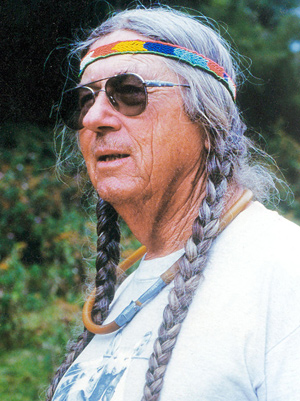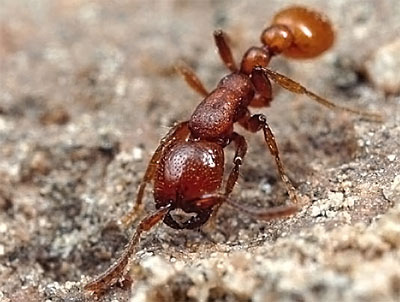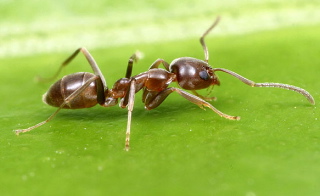
May 12, 2008

Roy Snelling (1934-2008).

Cryptozoologically, insects are not really in the realm of animals that Bernard Heuvelmans, myself and others strictly defined as of interest to the field, but nevertheless, we must admire those toiling to make the new discoveries of all those little animals out there that remain to be described.
One such giant in that arena of insects is to be celebrated in his passing.
For many of us, our first intrigue may have been with the tiny crawling and flying things found around our backyards, and for some, such as this explorer of the kingdom of ants, the fascination remained for a lifetime.
Roy Snelling, one of the greatest ant discoverers of our time, has passed away.
His son Gordon announced the sad news on their The Ant Farm and Myrmecology Forum:
Roy Snelling has left the building.
It is with great regret that I bring to you word of the passing of my father Roy.
He was just beginning a three month field stay in Kenya having arrived there only last Friday.
He passed away quietly in his sleep of an apparent heart attack.
Anyone knowing Roy will notice that going in ones sleep is not his style but at least he was in the field doing what he loved. Mrmacophyl
On May 12, 2008, Jocelyn Y. Stewart, Los Angeles Times staff writer, crafted a good tribute to the dynamic discoverer of many ants and other insects. (I share it below in a form in which I can retain the italics in the scientific names.)
+++
Roy Snelling, an internationally renowned entomologist who turned his boyhood fascination with insects into a lifelong study of the secret world of ants, wasps and bees, has died. He was 73.

This ant species is one of many described by Roy Snelling, Neivamyrmex wilsoni. Photo by Alex Wild
Snelling died in his sleep April 21, apparently after suffering a heart attack while in Kenya conducting a field study of rare ants and bees.
The world Snelling dedicated his life to understanding is one that most people know only vaguely, and then only as an annoyance: a buzzing, stinging, crawling menace to picnics and backyard barbecues.
During his 30-year career at the Natural History Museum of Los Angeles County — the last six as collections manager — Snelling became a leading expert in all things hymenoptera. He amassed a premier research collection of ants, his specialty.
Where the layperson sees a trail of black ants crawling up a kitchen wall — wholly unremarkable — Snelling saw a sliver of a huge, diverse kingdom. Ants are mostly beneficial, but there are ants that destroy crops, ants that damage wood by tunneling and nesting in it, ants that ravage other species of ants.
In Southern California the ant on the wall probably is an Argentine ant, which is not native but has taken up residence and invaded many a home.

Among the insects Roy Snelling studied is the common Argentine ant, Linepithema humile. Photo by Alex Wild
For all their abundance, and our proximity to them, “we know very little about the ant,” Snelling said in a 1965 Times article. “Scientists have been studying ants for only 100 years.”
So Snelling traveled the world looking under rocks, setting out chicken scraps as bait and sometimes climbing to the tops of mountains while searching for ant colonies. His studies are the primary reference for the honeypot ants of North America, groups of carpenter ants and the ant life of Chile.
In 1965, when he was 30 and one of only 10 myrmecologists in the world, Snelling followed a hunch and for two years searched for a colony of Nobomessor cockerellis. The shiny, black, slender, termite-eating ant had not been seen in California before. Snelling found the colony on a desert peak 50 miles southwest of Needles and observed it for 44 hours.
Lying on his stomach watching and sometimes listening — a few species make noises by snapping their jaws or rubbing their legs together — Snelling understood the lives of ants: how they relate to one another, how they interact with the environment, their social order.
“Big, healthy ants are always females,” he told The Times in 1965. “Straggly, miserable-looking ants are always males. It’s strictly a female’s world. . . . When the act of mating is completed, in a matter of seconds the male drops dead.” A queen ant can live as long as 15 years.
Snelling’s interest in insects began in Turlock, Calif., where he was born Sept. 30, 1934. As a boy he spent his lunch breaks in the fields near his school “out poking around, looking for critters,” said his son, Gordon, who also is an entomologist.
Roy Snelling’s father, who was a farmer, and his mother “thought he was nuts,” Gordon Snelling said. “But he became successful at it and his parents saw it wasn’t a lark.”
After attending community college in Modesto for a year and a half, Snelling dropped out and trained himself. In 1959, after a stint in the Army, he worked with the California Department of Agriculture, inspecting silos, granaries and barns for plant pests and helping eradicate them. He joined the county museum in 1963 and retired in 1993.
Snelling also was an ant taxonomist — one of a small circle who describe and name new species. He found previously undocumented species and placed them in ant annals.
He described and named many ant species, including Myrmecocystus tenuinodis, the honeypot ant, and Myrmecocystus wheeleri, after a noted myrmecologist. Proud of his Cherokee heritage, Snelling sometimes used Native American references in naming ants.

Snelling discovered and wrote about Myrmecocystus tenuinodis. Photo by Alex Wild
Snelling’s work in taxonomy is as significant as that of a mapmaker, said Jack Longino, a colleague and professor of entomology at Evergreen State College in Olympia, Wash.
“You’re making a map of the biodiversity of the planet,” Longino said. “You need these maps. You need the names and identifications of these things, to know what these introduced ants are and to be aware of them when they arrive.”
This summer Snelling was scheduled to teach at the Ant Course, a camp for ant biologists, as he has in years past. Instead, entomologists are mourning his loss on blogs. To them he was the generous curmudgeon who enjoyed classical music, the Southwestern desert, Mexican food and knowing the world of insects.

Another species also studied by Snelling was Stenamma dyscheres. Photo by Alex Wild
“Off to the big anthill in the sky,” wrote Corrie Moreau on Myrmecos Blog. “The ant community is a better place for your contributions both scientifically and personally.”
In addition to his son Gordon, Snelling, who was married and divorced twice, is survived by another son, Michael Duffy of San Carlos, Calif.; a daughter, Shelley Duffy of Fresno; and a brother, Clarence Snelling of Turlock.
A memorial service will be held at a later date.
About Loren Coleman
Loren Coleman is one of the world’s leading cryptozoologists, some say “the” leading living cryptozoologist. Certainly, he is acknowledged as the current living American researcher and writer who has most popularized cryptozoology in the late 20th and early 21st centuries.
Starting his fieldwork and investigations in 1960, after traveling and trekking extensively in pursuit of cryptozoological mysteries, Coleman began writing to share his experiences in 1969. An honorary member of Ivan T. Sanderson’s Society for the Investigation of the Unexplained in the 1970s, Coleman has been bestowed with similar honorary memberships of the North Idaho College Cryptozoology Club in 1983, and in subsequent years, that of the British Columbia Scientific Cryptozoology Club, CryptoSafari International, and other international organizations. He was also a Life Member and Benefactor of the International Society of Cryptozoology (now-defunct).
Loren Coleman’s daily blog, as a member of the Cryptomundo Team, served as an ongoing avenue of communication for the ever-growing body of cryptozoo news from 2005 through 2013. He returned as an infrequent contributor beginning Halloween week of 2015.
Coleman is the founder in 2003, and current director of the International Cryptozoology Museum in Portland, Maine.
Filed under Breaking News, Classic Animals of Discovery, Cryptotourism, CryptoZoo News, Cryptozoologists, Cryptozoology, Men in Cryptozoology, New Species, Obituaries